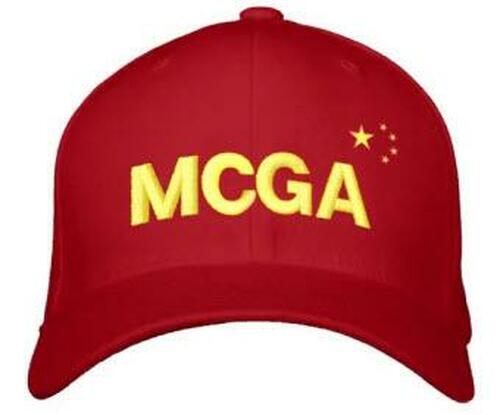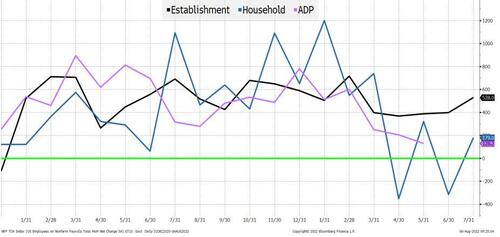Things You Will Never See
Authored by Peter Tchir via Academy Securities,
Things You Will Never See
You will never see a “Make China Great Again” hat because China has always been about making China great. Whatever illusions we have had to the contrary are continually getting chipped away and nothing about the events of this past week gives me comfort on the longer-term trajectory of how we will conduct business with China. Hopefully I’m overly pessimistic, but at the moment, it seems like many of Academy’s views on the direction that China is heading continue to play out in real time. No similar Russian hats either, as every day is Make Russia Great Again, at least in Putin’s eyes and via state media. Also, I think that given what we’ve seen with India buying Russian commodities, Brazil signing up for Russian diesel, and various other countries aligning themselves to trade with parties most beneficial to themselves (and their people/their leaders), we won’t see hats like this from other countries. There was a lot wrong with how the Make America Great Again theme was presented. It was crass and vulgar, but I just can’t help but believe the fact that so many other countries are taking the same concept and ignoring this behavior (or pretending it doesn’t happen) will lead us to poor longer-term decisions.
I am not trying to make a political statement. I do not want to condone one sort of behavior over another. But I do want to shock you! I could not think of a better image to draw your attention to something that is not only shaping the global economy, but is accelerating that re-shaping as this not-so-subtle message sinks in. I’m still a big believer that we are re-shaping supply chains around “closeness” where “closeness” will mean politically aligned, morally aligned, and/or includes geographic proximity as physical closeness offers at least the perception of better security.
Things You Don’t See Often
Moving away from the potentially politically charged first paragraph, there are some things that I don’t expect to see (at least not often), but we saw them last week:
-
The 2-year Treasury yield going 20 bps higher in a morning on Fedspeak, only to get back to unchanged with very little in the way of explanation.
-
Very aggressive military exercises by China around Taiwan.
-
Made in Taiwan, China, or Chinese Taipei labels. I still haven’t seen the labels, but it sounds like China is attempting to enforce some existing rules on how products being imported from Taiwan into mainland China must be labelled. This seems like yet another step to prepare the world to accept that Taiwan is just another part of China (even while China treats the goods as “imports”). All a bit strange, but worth watching.
-
Very inconsistent employment data. We had an epic beat on jobs on Friday – more than double the average estimate and over 200,000 stronger than the highest estimate. Anecdotally, no matter what you think of Wall Street economists, they usually aren’t that far off. My experience, which is purely subjective and based on my own recollections, is that more often than not, the data gets revised closer to where the Street was, rather than the other way around. Not always, but that is my gut on how it works. The Household data wasn’t as strong and ADP didn’t print as they are in the middle of changes, but they too had been lagging the Establishment Survey.
There are always deviations in the various reports, but since April (4 reports) the Establishment Survey says we’ve created 1.7 million jobs, while the Household Survey says we’ve lost almost 200 thousand jobs! What is 2 million jobs between friends? Even if they meet in the middle, job growth isn’t likely as strong as the headline, but the unemployment rate may be much lower than the headline (unemployment rates are based on the Household data).
-
There was progress on a sustainable energy bill where China will be a big beneficiary given their dominance in solar panels and strength in battery production. Ironically, this is just as China steps away from working with the U.S. on climate change efforts and a lot of questions remain about how “clean” the production is of these “clean” energy sources. Okay, I will admit that, as a cynic, this is more par for the course than something I wouldn’t expect to see. The concept of growing both traditional and sustainable energy production is something I’ve supported, but the current bill seems to barely scratch the surface, some seemingly obvious solutions are left out, and it doesn’t seem like it is enough to ensure that the supplies are coming from suppliers that fit the overall aims of the goal. I also believe that this bill will be inflationary, at least during the buildout stage, which I think is okay as the “no pain, no gain” mantra comes to mind and if we are really going to “fix” things, there will be some short-term pain we are likely to endure.
-
Inventory Builds and Curve Inversion. On Thursday we published our concerns about Inversion and Inventories. My biggest concern for the economy is the inventory build-out. Unlike the jobs data, the inventory data is unequivocal, it is rising rapidly, and will need an uptick in spending from consumers and companies to right itself (which is why the jobs data is so important). The inversion, which is a second order concern to me, saw 2s vs 10s finish at -40 bps, which is pretty extreme by historical standards.
-
A large asset manager and crypto focused company announced plans to partner and bitcoin barely budged. That sort of headline (a couple of years ago) would have sent crypto much higher in my opinion, so it is curious (not in a good way) that it didn’t respond strongly.
I am sure I could go on with a list of unusual sightings, but that covers it for now.
Bottom Line
I wanted the hat to shock you, but not offend you. Apologies if I offended anyone as my intention is not to get cancelled, but really to get a visceral reaction when thinking about where we are across the globe when what was once “just” economic competition seems to be sliding rapidly into geopolitical tension.
The employment data is going to force the Fed to continue to sound hawkish. Wage pressures were evident, which would be consistent with a lower unemployment rate if the Household side had missed a lot of jobs.
Everyone seems to have a whisper number for CPI that is much lower than the expected estimate. That could take some pressure off of the Fed, especially with commodity prices weak (energy led the way lower with WTI down 10% this week, but weakness was apparent throughout most of the commodity complex).
Could bonds and equities rally on a weaker than expected CPI number? Yes, but that seems largely priced in, and I think that the Fed will have to pay more attention to jobs and wage inflation than any decrease in CPI. However, I’m willing to bet there is a chance that before year-end, we are freaking out about deflation rather than fighting inflation, but that is for another day, and certainly a day when China isn’t displaying their might in the region. If anything escalates with China (even just on the trade side), it will hit markets rapidly.
With the 10-year back to 2.83% we can nibble again. Momentum right now is pushing to slightly higher yields, but CPI does seem likely to assuage markets. Consumers and inventories will play a big role in driving yields lower (if I’m correct), but that isn’t a “tomorrow” story necessarily.
The S&P 500 was up 0.4% last week, with the NASDAQ and Russell 2000 both up around 2%. I still like owning puts and calls and waiting for a breakout. Disruptive stocks had a very strong week, including on Friday when higher yields gave them an excuse to perform poorly (but they didn’t). That price action on Friday was encouraging because it seemed more like a true risk-taking day rather than a bear market rally short squeeze. I think that pattern is too early, but I respect it and am intrigued at the possibility.
I continue to like credit and I am hearing more and more “yield” investors are scouring through the universe of high-quality investment grade corporate bonds that trade at relatively low dollar prices (because of the move in yields, not spreads). This follows our “QT” work and allows people to achieve similar returns with lower risk, so that trend should continue. The only caveat to this is that it seems to offer better support to the secondary market than the primary market as this low dollar price is both important and only available in the secondary. It is supportive of the primary, but the secondary will lead the way.
Europe remains an issue. European credit spreads (ITRX MAIN) widened a touch while U.S. CDS spreads were unchanged. European stocks were unchanged while the EUR continues to languish near par. I am not sure what it will take for Europe to bounce (probably extraordinary supportive bond buying programs), but until that happens, it will function as an anchor for markets globally.
While I like commodities and emerging markets, the sectors that seem to have the best risk reward (too much bad priced in, too little good) are financials (European financials in particular) and homebuilders / real estate.
Good luck and this seems like it has already been a long and tiring year and I don’t see the volatility and flip flopping between fear and greed changing anytime soon, especially as we all fixate more and more on where we are potentially headed with China.
Tyler Durden
Sun, 08/07/2022 – 14:30
via ZeroHedge News https://ift.tt/Ma2beYT Tyler Durden

